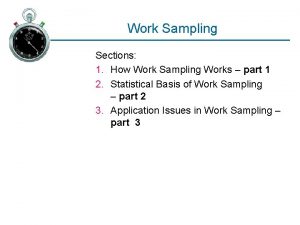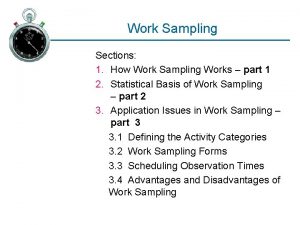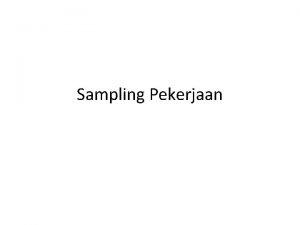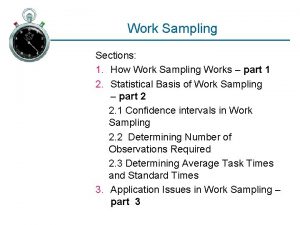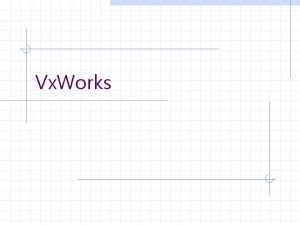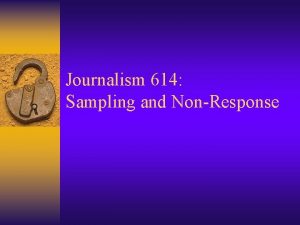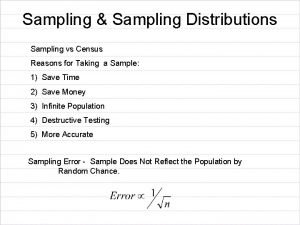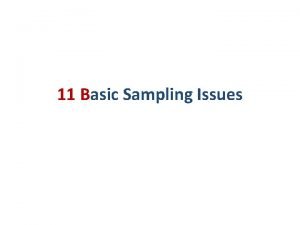Work Sampling Sections 1 How Work Sampling Works

















- Slides: 17

Work Sampling Sections: 1. How Work Sampling Works – part 1 2. Statistical Basis of Work Sampling – part 2 3. Application Issues in Work Sampling – part 3 3. 1 Defining the Activity Categories 3. 2 Work Sampling Forms 3. 3 Scheduling Observation Times 3. 4 Advantages and Disadvantages of Work Sampling

Work Sampling 3. Application Issues in Work Sampling

Application Issues in Work Sampling § Work sampling must be custom-designed for specific problem it is intended to address § But general steps summarized in Table 1 (reading assignment # 2) § We will focus here on following WS steps/issues: 1. defining the activity categories (Table 1 – 4) 2. work sampling forms (Table 1 – 5. a) 3. scheduling the observation times (Table 1 – 5. d)

3. 1 Defining the Activity Categories § Activity categories must be: § Consistent with objectives of study § Immediately recognizable by observer § Mutually exclusive (each category distinguishable from others) § If output measures are included in study, § activity categories must correlate with those measures (e. g. 3 outputs 3 categories) § activity categories must be defined for specific study being conducted

3. 1 Defining the Activity Categories §

3. 1 Defining the Activity Categories Examples of possible activity categories for various types of work

3. 1 Defining the Activity Categories Examples of possible activity categories for various types of work

3. 2 Work Sampling Observation Form § Forms in WS study must be designed specifically for given study § Each study is different from all others in § activity categories § subjects § total number of observations, § and time period § Form must be: § easy and convenient to use § enable making snap readings of subject(s) § enable quick recording of data

3. 2 Work Sampling Observation Form

3. 3 Scheduling the Observation Times § Total # of observations in WS study § usually large (several thousand) § # must be reduced to schedule of observations § randomizing observation times § improves statistical accuracy § reduces bias

3. 3 Scheduling the Observation Times §

3. 3 Scheduling the Observation Times § Method 2 of randomization: § use principle of sampling stratification*: § total # of observations divided into specified # of time periods (e. g. days, ½-days, hrs) § equal # of samples taken in each period § In e. g. 1: § 5 -day period § 10 randomized observation rounds/day § Further step : 5 randomized observations each ½-day (e. g. , 5: morning, 5: afternoon) § reduce variance in WS study § Also: more convenient for observers

3. 3 Scheduling the Observation Times §

e. g. 5: Random Observation Times

cont. e. g. 5:

3. 4 Advantages of Work Sampling § Can be used to measure activities that are impractical to measure by direct observation § Multiple subjects can be included § Requires less time and lower cost than continuous direct observation § Training requirements less than DTS or PMTS § Less tiresome and tedious on observer than continuous observation § Subject in WS: less demanding than being watched continuously for a long time

3. 4 Disadvantages and Limitations § Not as accurate for setting time standards as other work measurement techniques § Usually not practical for studying single subject § Work sampling provides less detailed information about work elements than DTS or PMTS § Since work sampling deals with multiple subjects, individual differences will be missed § Workers may be suspicious because they do not understand the statistical basis of work sampling § Behavior of subjects may be influenced by the act of observing them
 Street works risk assessment
Street works risk assessment Working present continuous
Working present continuous Health and safety at work etc act 1974 section 2
Health and safety at work etc act 1974 section 2 Probability vs non probability sampling
Probability vs non probability sampling Quota sampling definition
Quota sampling definition Cluster random sampling vs stratified
Cluster random sampling vs stratified Contoh event sampling adalah
Contoh event sampling adalah Cluster sampling vs stratified random sampling
Cluster sampling vs stratified random sampling Two-stage cluster sampling example
Two-stage cluster sampling example Natural sampling vs flat top sampling
Natural sampling vs flat top sampling Communication works for those who work at it
Communication works for those who work at it Apa itu work sampling
Apa itu work sampling Wso work sampling
Wso work sampling Work sampling technique
Work sampling technique Work sampling definition
Work sampling definition Work sampling technique
Work sampling technique Pengertian work sampling
Pengertian work sampling How to find volume of a semi circle
How to find volume of a semi circle













